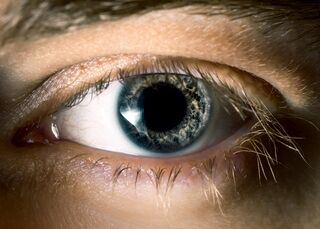Neuroscience
When Is the Size of Someone’s Pupils Like a Crystal Ball?
Pupil size changes may forecast the odds of longevity in heart failure patients.
Posted August 10, 2020 Reviewed by Ekua Hagan

The eyes are a window into our autonomic nervous system. Everyone's unique personal history and autobiographical experiences have the power to influence how and when the sympathetic nervous system (SNS) or the parasympathetic nervous system (PNS) causes pupils to dilate or constrict. In a push-pull dynamic, the "rest and digest" functions of the PNS make pupils smaller; whereas, the "fight or flight" response of the SNS makes pupils bigger.
In July 2020, a pioneering pupillometry study (McKinnon, Gray & Snowden, 2020) identified how and when an individual's pupils change size might give scientists valuable insights into whether or not someone exposed to trauma is living with post-traumatic stress disorder. In this context, how someone's pupils constrict or dilate in response to emotional stimuli and changes in ambient light can reveal hidden clues about one's past.
Aimee McKinnon, Nicola Gray, and Robert Snowden found that if someone has PTSD, his or her parasympathetic response is less robust, which causes pupils to constrict slowly and stay wider in diameter for longer. (See "If Eyes Are a Window to the Soul, Our Pupils May Reveal PTSD")
Pupillometry can pick up traces of traumatic exposure that linger in the nervous system like scar tissue. As an analogy: Archaeologists can unearth clues about how ancient people suffered in a natural disaster such as Pompeii, based on their fossilized remains. When it comes to modern-day people living with PTSD, pupillometry allows scientists to excavate buried traumatic memories held (like relics from the past) in a dysregulated autonomic nervous system.

Now, another new study (Nozaki et al., 2020) suggests that pupil size may also provide a window into someone's future. Unlike the woo-woo (and completely unscientific) predictions from a fortune-telling crystal ball, Ouija board, or Magic 8-Ball, evaluating autonomic functions via changes in pupil size may be a science-based way to forecast health-related aspects of someone's future and his or her longevity.
More specifically, a team of researchers in Japan recently identified pupil size's prognostic ability to assess all-cause mortality risk in heart patients. These findings by first author Kohei Nozaki of Kitasato University Hospital and colleagues were published on August 10 in the European Society of Cardiology's journal ESC Heart Failure.
The cohort for this study included hundreds of men and women (N = 870) who were hospitalized for acute heart failure between 2012 and 2017. After leaving the hospital, each study participant returned for a check-up and had the pupil area in both eyes photographed in a darkened room using a special goggle-fitted camera capable of taking 60 frames per second. Pupil size was systematically measured at the same time of day (between 9 a.m. and 12 p.m. noon).
Because atypical functioning of the autonomic nervous system is associated with heart failure, how pupil size changes when a heart patient is in a darkened room provides insights into their PNS, SNS, and overall autonomic functions. As Takuya Kishi explained almost a decade ago in a paper, "Heart Failure as an Autonomic Nervous System Dysfunction" (Kishi, 2012):
"In heart failure, it has been recognized that the sympathetic nervous system (SNS) is activated and the imbalance of the activity of the SNS and vagal activity interaction occurs. The abnormal activation of the SNS leads to further worsening of heart failure. We must recognize that heart failure is a complex syndrome with an autonomic nervous system dysfunction, and that the autonomic imbalance with the activation of the SNS and the reduction of [vagus nerve] activity should be treated."
If someone has healthy autonomic functions, his or her pupils will dilate significantly after being in a dark room for a few minutes. However, in patients with heart failure, autonomic dysfunctions inhibit the pupil light reflex (PLR), aka pupillary reflex, from constricting or dilating pupil size appropriately in response to changes in environmental light.
As Nozaki et al. explain in their recent (2020) paper:
"Typical autonomic nervous dysregulation in heart failure involves sympathetic activation or parasympathetic suppression, in which the pupil is dilated, thus increasing its area. However, the results of the present study suggested that small pupil area was associated with poor prognosis in patients with HF. Although the mechanism underlying this association has yet to be determined, we postulated that it may be similar to the mechanism of chronotropic incompetence."
"Our results suggest that pupil area is a novel way to identify heart patients at elevated risk of death or hospital readmission," Nozaki said in a news release. "Finding better ways to pinpoint which patients are more likely to be readmitted or die is crucial." The prognostic value of pupil size measurements provides a non-invasive opportunity to forecast a heart patient's risk of all-cause mortality and to address autonomic dysfunctions.
"Pupil area can be obtained rapidly, easily, and non-invasively. Our study indicates that it could be used in daily clinical practice to predict prognosis in patients with heart failure, including those who also have atrial fibrillation," Nozaki concluded. "Patients with a small pupil area (e.g., less than 16.6 mm) could be prioritized for cardiac rehabilitation with physical activity, which has been reported to improve autonomic function."
References
Kohei Nozaki, Nobuaki Hamazaki, Shohei Yamamoto, Kentaro Kamiya, Shinya Tanaka, Takafumi Ichikawa, Takeshi Nakamura, Masashi Yamashita, Emi Maekawa, Atsuhiko Matsunaga, Minako Yamaoka‐Tojo, Junya Ako. "Prognostic Value of Pupil Area for All-Cause Mortality in Patients With Heart Failure." ESC Heart Failure (First published: August 10, 2020) DOI: 10.1002/ehf2.12933
Aimee I. McKinnon, Nicola S. Gray, Robert J. Snowden. "Enhanced Emotional Response to Both Negative and Positive Images in Post-Traumatic Stress Disorder: Evidence From Pupillometry." Biological Psychology (First published online: June 18, 2020) DOI: 10.1016/j.biopsycho.2020.107922




